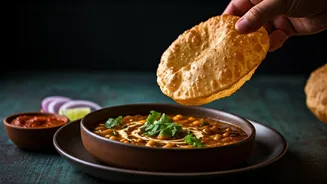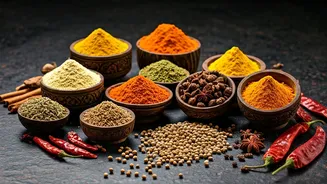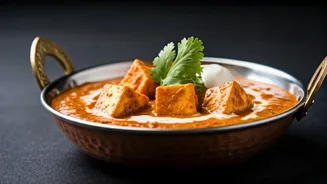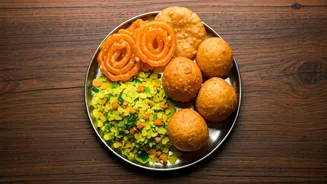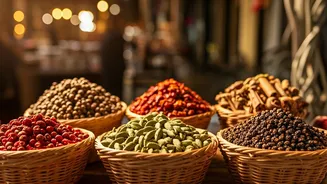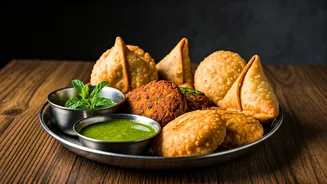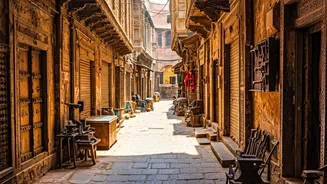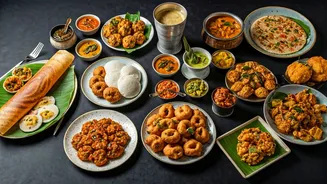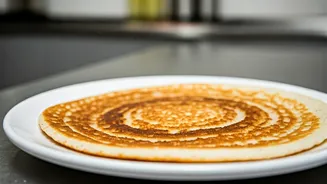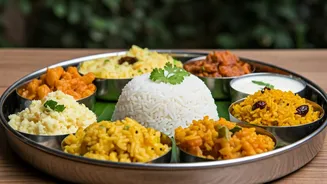Origins and History
The origins of chhole bhature in Delhi are intertwined with the culinary migration and evolution of the city. While the exact genesis is debated, the dish
gained prominence in Delhi during the early to mid-20th century. This flavorful combination, consisting of a spicy chickpea curry (chhole) served with fluffy, deep-fried bread (bhature), quickly became a favorite. Over time, various vendors and restaurants began offering their unique versions, each with slight variations in the spice mix and preparation methods, thus contributing to the dish's diversified appeal. The influence of Punjabi cuisine, which emphasizes rich, flavorful dishes, played a major role in shaping the dish. The dish's appeal also owes to its availability and accessibility, rapidly solidifying its place as one of the most loved street foods in the capital.
Key Ingredients Defined
Understanding the core components of chhole bhature is essential to appreciating its distinct flavor profile. The chhole, or chickpea curry, is typically made with dried chickpeas, which are soaked overnight and then simmered with a blend of aromatic spices like cumin, coriander, turmeric, and chili powder. A key ingredient is the addition of anardana (dried pomegranate seeds) which adds a slightly sour taste. Tomatoes, onions, and ginger-garlic paste contribute to the base of the curry, creating a rich and flavorful gravy. The bhature, on the other hand, are made from a leavened dough, often including all-purpose flour, yogurt, and semolina, which is then deep-fried until it puffs up into golden, airy bread. The addition of ingredients like baking soda allows the bhature to become fluffy and easily digestible.
Preparation Methods Unveiled
The preparation of chhole bhature involves several steps, each critical to the final outcome. The chhole are carefully cooked, allowing the spices to meld with the chickpeas, achieving the required flavor intensity and tenderness. The cooking process is often lengthy, with the chickpeas needing to reach the perfect softness. The bhature dough undergoes a rising process, often taking a few hours, to develop its characteristic fluffiness. Deep frying the bhature requires achieving the right oil temperature to ensure the bread puffs up correctly. The overall preparation is a balance of patience and attention to detail. Vendors often have their unique techniques passed down through generations. These methods are what impart the distinct character and taste that have made chhole bhature such a celebrated street food.
Cultural Significance in Delhi
Chhole bhature holds a significant cultural place in Delhi, extending beyond its appeal as a mere dish. It is a symbol of street food culture, representing the city's lively character and its people's love for flavorful, affordable food. The dish is not just a meal; it is a social experience, frequently enjoyed on the streets, at local eateries, and on special occasions. It brings together people from different backgrounds, fostering a sense of community. The availability of chhole bhature at almost every corner of the city also reflects its embeddedness within the urban fabric of Delhi, as it caters to residents' day-to-day culinary needs. It has also become a representation of the city's culinary identity, which is often promoted during festivals and cultural events.
Best Places to Eat
Delhi is replete with establishments offering chhole bhature, each with its unique flavor profile, allowing the consumer to experience a wide array of flavors. Some popular places include small street-side stalls that have been running for generations, as well as renowned restaurants. These vendors usually focus on fresh ingredients and time-honored techniques. The best places are often distinguished by the long queues of hungry patrons, which serve as a testimonial to the taste and quality of the food. These well-regarded locales often emphasize the balance of flavor and spice. Exploring various vendors is a great way to fully experience the diversity and richness of Delhi's chhole bhature offerings.
Variations and Regional Influences
While the core components of chhole bhature remain consistent, regional influences and personal preferences lead to many variations of the dish. Some variations include different spice levels, the addition of specific ingredients. In some places, vendors serve chhole bhature with various accompaniments, such as onions, pickles, and chutneys, that enhance the flavor profile. The influence of Punjabi cuisine is clear, but many vendors have incorporated their personal tastes. The evolution of the dish showcases the adaptability of street food and its capacity to incorporate the wide-ranging preferences of the people.
